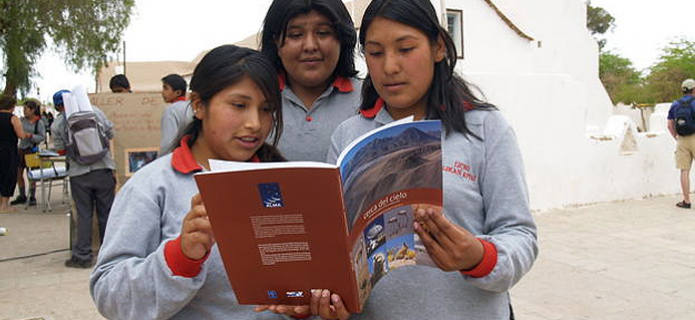Close to the Sky: New book on fauna and flora at ALMA site just published
22 November, 2007 / Read time: 2 minutes
Entitled "Close to the sky: Biological heritage in the ALMA area", and edited in English and Spanish by ESO in Chile, the book collects unique on-site observations of the flora and fauna of the ALMA region performed by experts commissioned to investigate it and to provide key initiatives to protect it.
"I thank the ALMA project for providing us a book that will surely be a good support for the education of children and youngsters of San Pedro de Atacama. Thanks to this publication, we expect our rich flora and fauna to be better known. I invite teachers and students to take advantage of this educational resource, which will be available in our schools", commented Ms. Sandra Berna, the Mayor of San Pedro de Atacama, who was given the book by representatives of the ALMA global collaboration project.
Copies of the book 'Close to the sky' will be donated to all schools in the area, as a contribution to the education of students and young people in northern Chile.
"From the very beginning of the project, ALMA construction has had a firm commitment to environment and local culture, protecting unique flora and fauna species and preserving old estancias belonging to the Likan Antai culture," said Jacques Lassalle, who represented ALMA at the hand-over. "Animals like the llama, the fox or the condor do not only live in the region where ALMA is now being built, but they are also key elements of the ancient Andean constellations. In this sense they are part of the same sky that will be explored by ALMA in the near future."
The ALMA Project is a giant, international observatory currently under construction on the high-altitude Chajnantor site in Chile. ALMA will be composed initially of 66 high-precision telescopes, operating at wavelengths of 0.3 to 9.6 mm. The ALMA antennas will be electronically combined and will provide astronomical observations which are equivalent to those from a single large telescope of tremendous size and resolution.
Chajnantor was selected as the ideal spot for ALMA, following several years of atmospheric and meteorology studies. The high elevation, stable atmosphere, and low humidity make it one of the best locations in the world for radio astronomy. To protect the outstanding conditions of Chajnantor, the Government of Chile declared a major portion of the area a scientific reserve.
